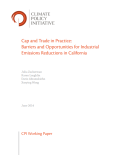The overriding challenge for many European governments today is to reduce major fiscal deficits with the least collateral damage to the economy. This report shows that carbon fiscal measures may raise significant revenues while having a less detrimental macro-economic impact than other tax options. This gives them an important potential role in fiscal policy; a role that is currently widely overlooked. This benefit arising from carbon fiscal measures goes beyond the usual arguments in their favour – namely that they are crucial, cost effective instruments to reduce Europe’s greenhouse gas emissions. The main focus of this report has been on the immediate opportunities for carbon pricing to assist with deficit reduction. In addition to this, the report explores whether there may also be longer term opportunities to raise greater revenue from carbon pricing while improving the efficiency and effectiveness of the EU ETS.
The Government of India has ambitious renewable energy targets, but limited financial resources to meet those targets. CPI examines how much it would cost the government to reach its renewable energy targets, by comparing the levelized cost of electricity from renewable energy to a baseline fossil fuel in absence of any subsidies – whether explicit or implicit; estimating the total cost of support for renewable energy under accelerated depreciation to determine which is the most cost-effective of existing policies; and investigating federal policy options to make this support even more cost-effective. The paper is organized in five sections. After the first section of introduction, section 2 discusses the selection of imported coal as the baseline cost of electricity for comparison with renewable energy. Section 3 forecasts and compares the levelized cost of electricity from renewable energy and the baseline of imported coal. Section 4 examines the cost of government support for renewable energy under different policy pathways. Section 5 presents policy implications.

California is both one of the largest economies and one of the largest emitters globally, making its climate change policies some of the most important in the world. They are also some of the most ambitious. In particular, California’s Global Warming Solutions Act of 2006 (AB32) set a series of policies and programs across all major business sectors to return California emissions to 1990 levels by 2020. A key component of this set of policies is the Cap and Trade Program, which caps greenhouse gas (GHG) emissions from key business sectors in California. With the Cap and Trade Program in its second year of full operation, CPI studies how firms make business decisions in the presence of a carbon price — whether abatement options that have been identified as technically feasible prove to be attractive in practice, or whether barriers prevent firms from pursuing otherwise cost-effective abatement options.

This report was launched at the 7th World Water Forum in Daegu, Gyeongbuk, Republic of Korea. It presents the research conducted from 2011 - 2014, a new theoretical approach, a revised analytical framework and recommendations for policy makers to begin the process of implementing water and green growth strategies. The report provides a recap of the history and rationale behind the development of the Water and Green Growth Project and concept. The analytical framework used in the report has been developed through numerous discussions between experts in various fields and encompasses strategic, institutional, and practical approaches.
China’s drive to develop a low-carbon, resource-efficient economy is a top priority of the government, placing pressure on the industrial development zones (IDZs) to respond to a growing and diverse set of policy levers. The International Institute for Sustainable Development (IISD), with the support of the Swiss State Secretariat for Economic Affairs (SECO) and the Chinese Ministry of Commerce (MOFCOM), is working with Chinese industrial and economics zones to identify key policy trends that will affect competitiveness and to provide insight to help better manage the transition to a low-carbon, resource-efficient economy. This synthesis report provides an overview of the two phases of the project, which a specific focus on the low-carbon drivers of IDZs, an overview of the research results, policy trends and drivers of low-carbon development in IDZs and Priority areas for action.
